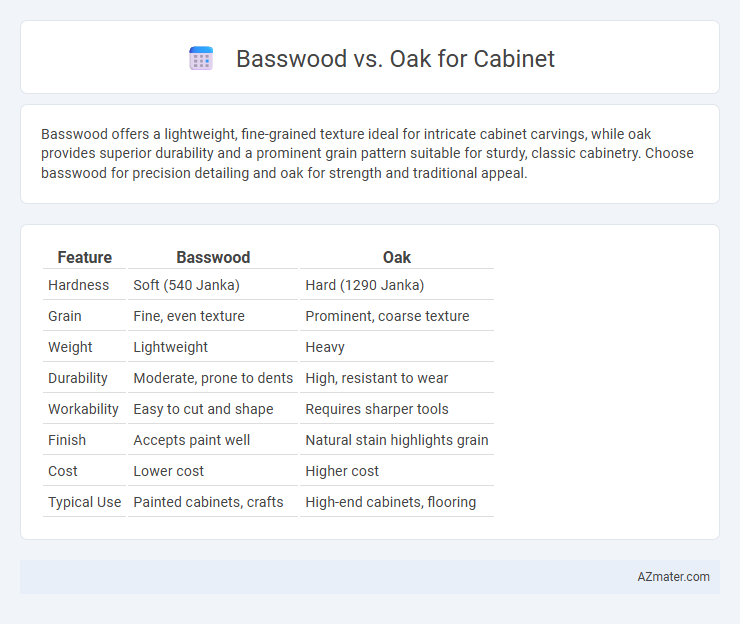Basswood offers a lightweight, fine-grained texture ideal for intricate cabinet carvings, while oak provides superior durability and a prominent grain pattern suitable for sturdy, classic cabinetry. Choose basswood for precision detailing and oak for strength and traditional appeal.
Table of Comparison
| Feature | Basswood | Oak |
|---|---|---|
| Hardness | Soft (540 Janka) | Hard (1290 Janka) |
| Grain | Fine, even texture | Prominent, coarse texture |
| Weight | Lightweight | Heavy |
| Durability | Moderate, prone to dents | High, resistant to wear |
| Workability | Easy to cut and shape | Requires sharper tools |
| Finish | Accepts paint well | Natural stain highlights grain |
| Cost | Lower cost | Higher cost |
| Typical Use | Painted cabinets, crafts | High-end cabinets, flooring |
Introduction to Basswood and Oak for Cabinetry
Basswood and oak are two popular wood choices for cabinetry, each offering distinct characteristics suited for different design preferences. Basswood is a lightweight, soft hardwood known for its fine, even texture and pale color, making it easy to paint or stain, ideal for intricate carving and detailed cabinetry work. Oak, a dense and durable hardwood with prominent grain patterns and a warm, natural finish, provides strength and resistance to wear, often favored for traditional and rustic cabinetry styles.
Key Features of Basswood Cabinets
Basswood cabinets are prized for their fine, even texture and soft grain, which allow for smooth finishes and intricate carving, making them ideal for detailed cabinetry work. Unlike oak, which has a coarse grain and is notably harder, basswood offers greater workability and is lighter in weight, facilitating easier installation and customization. Its pale, consistent color provides a versatile canvas for paint or stain, enhancing the aesthetic appeal of cabinets in various design styles.
Key Features of Oak Cabinets
Oak cabinets are prized for their durability, prominent grain patterns, and natural resistance to wear, making them a long-lasting choice for kitchens and bathrooms. The dense hardwood structure of oak provides excellent strength, allowing for better support of heavy hardware and repeated use without warping or denting. Oak's natural ability to accept stains and finishes enhances its versatility, enabling a range of aesthetic options from traditional to contemporary styles in cabinetry.
Durability Comparison: Basswood vs Oak
Oak cabinets exhibit superior durability due to their dense hardwood structure, providing excellent resistance to dents, scratches, and daily wear, making them ideal for high-traffic kitchen environments. Basswood, while softer and lighter, offers moderate durability but is more prone to dents and scratches, requiring careful maintenance to preserve its appearance. Choosing oak enhances cabinet longevity and structural integrity, while basswood suits designs prioritizing ease of carving and a smooth finish over maximum durability.
Grain and Aesthetic Differences
Basswood features a fine, even grain with a smooth texture, making it ideal for painted cabinet finishes that require a uniform surface. Oak, characterized by its prominent, open grain and natural variation, offers a more rustic and traditional aesthetic with visible knots and rays that add character. The choice between basswood and oak cabinets often depends on the desired look: sleek and modern with basswood or rich and textured with oak.
Workability and Ease of Finishing
Basswood offers superior workability for cabinets due to its soft, fine-grained texture, making it easy to carve, sand, and shape with hand or power tools. Oak, being a hardwood with a dense, coarse grain, can be more challenging to work with but provides excellent durability and strength. In terms of finishing, basswood accepts paint and stains uniformly, while oak's open grain requires careful surface preparation and may benefit from grain fillers to achieve a smooth, polished look.
Cost Analysis: Basswood vs Oak Cabinets
Basswood cabinets generally cost less than oak cabinets due to the wood's softer texture and faster growth rate, making it a more budget-friendly option for cabinetry. Oak cabinets, known for their durability and distinctive grain patterns, often come with a higher price tag reflecting the wood's strength and longevity. When considering long-term value, oak cabinets may require less maintenance and offer greater resale appeal, while basswood cabinets provide cost savings upfront without compromising a smooth finish for painting or staining.
Best Applications for Each Wood
Basswood excels in cabinet applications requiring a smooth, paint-ready surface due to its fine, even grain and lightweight nature, making it ideal for painted cabinetry or intricate designs. Oak, known for its strength and durability, is best suited for high-traffic kitchen or bathroom cabinets that benefit from its prominent grain pattern and resistance to wear. Selecting basswood maximizes ease of customization and finishing, while oak offers superior longevity and a classic, natural wood aesthetic.
Maintenance and Longevity
Basswood cabinets require less maintenance due to their soft texture and resistance to dents, making them ideal for frequent refinishing and painting. Oak cabinets offer superior durability and longevity with a dense grain structure that withstands wear, making them highly resistant to scratches and dents. Oak's resilience results in a longer lifespan, while basswood's ease of repair suits those prioritizing upkeep and aesthetic updates.
Which Wood Is Better for Your Cabinets?
Basswood offers a smooth, fine grain that is ideal for painting and detailed cabinetry work, making it a top choice for custom or decorative cabinets. Oak provides exceptional durability and a distinct grain pattern, which appeals to those seeking a natural and sturdy wood finish for high-traffic kitchen cabinets. Choosing between basswood and oak depends on whether you prioritize paintability and subtle texture (basswood) or strength and pronounced grain aesthetics (oak) for your cabinetry needs.

Infographic: Basswood vs Oak for Cabinet
 azmater.com
azmater.com